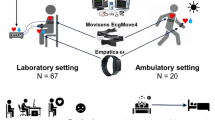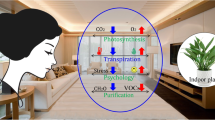Abstract
The purpose of this study was to determine the thermal comfort requirements for steps in temperature. Thirty male subjects were exposed for 50 min to a 34 or 37°C condition, and then quickly transferred to a cooler environment of 31, 28, 25, and 22°C for 50 min. Mean skin temperature was continuously measured, and the subjects reported their thermal sensation and comfort sensation every 2 min. Just after the step changes, the mean skin temperature immediately decreased, while the thermal sensation overshot and gradually rose again. Both the skin temperature and the thermal sensation seemed to reach a constant level within about 20 min. However, there were differences in the mean skin temperature and the neutral temperature derived from the correlation between the ambient temperature and the thermal sensation even 50 min after the steps, due to the thermal environmental condition before the changes of temperature. The change in the neutral temperature with time was expressed as two attenuating equations. These equations indicate that there is an obvious difference between the neutral temperatures due to the thermal condition before step changes, and that it takes >50 min after the step changes to reach the steady state. It is expected that these equations predict in quantitative terms the thermal comfort requirements within a given experimental condition.






Similar content being viewed by others
References
ASHRAE (1992) Standard 55. Thermal environment conditions for human occupancy. ASHRAE, Atlanta, Ga.
de Dear RJ, Knudsen HN, Fanger PO (1989) Impact of humidity on thermal comfort during step-changes. ASHRAE Trans 77:247–262
de Dear RJ, Ring JW, Fanger PO (1993) Thermal sensations resulting from sudden ambient temperature changes. Indoor Air Int J Indoor Air Qual Clim 3:181–192
Fanger PO (1970) Thermal comfort: analysis and application in environmental engineering. McGraw-Hill, New York
Fujita H, Konno H, Tanabe K (1994) Saiteki-ka hou (in Japanese). Iwanami Shoten, Tokyo, pp 73–108
Gagge AP, Stolwijk JAJ, Hardy JD (1967) Comfort and thermal sensations and associated physiological responses at various ambient temperature. Environ Res 1:1–20
Gagge AP, Stolwijk JAJ, Nishi Y (1971) An effective temperature scale based on a simple model of human physiological regulatory response. ASHRAE Trans 77:247–262
Hardy JD, DuBois EF (1938) The technic of measuring radiation and convection. J Nutr 15:461–475
Horie G, Sakurai Y, Matsubara N, Morimoto H (1985) Impulse response of skin temperature and thermal sensation. Joint Meeting CIB W17/77, Budapest, pp 1–10
Horikoshi T, Kobayashi Y (1978) Configuration factors between a rectangular solid as a model of the human body and rectangular planes, for evaluation of the influence of thermal radiation on the human body. II. Characteristics of configuration factors for the rectangular solids. Trans Architect Inst Jpn 267:91–101
Horikoshi T, Kobayashi Y, Tanaka M, Kawagoe K (1983) Evaluation and prediction of the influence of thermal environment upon the human skin temperature. Proceedings of the 4th International Symposium on the Use of Computers for Environmental Engineering Related to Buildings, pp 72–77
Horikoshi T, Fukaya Y (1993) Thermal sensation and comfort: responses of human skin temperature and thermal sensation to step change of air temperature. J Therm Biol 18:377–380
ISO (1994) International standard 7730: moderate thermal environments. Determination of the PMV and PPD indices and specification of the conditions for thermal comfort. ISO, Geneva
Kakitsuba N, Inoue Y (1998) Effects of relative humidity on physiological and psychological responses during cooling after hot exposure. In: ICHES98 Organizing Committee (eds) Proceedings of the 2nd International Conference on Human–Environment Systems, Yokohama, pp 97–100
Kurazumi Y, Horikoshi T, Tsuchikawa T, Matsubara N (1994) The body surface area of Japanese (in Japanese, English abstract). Jpn J Biometeorol 31(1):5–29
Matsumoto M (1984) Shikki (in Japanese). In: Shin-Taikei Henshu Iinkai (eds) Shin Kentiku-gaku Taikei. Shokoku-sha, Tokyo, vol 10, pp 105–182
Mori I, Hokoi S, Takada S, Tanaka H (2003) Experimental study on thermal sensation index in thermal transients (in Japanese, English abstract). Trans Architect Inst Jpn 563:9–15
Ring JW, de Dear RJ (1991) Temperature transients: a model for heat diffusion through the skin, thermoreceptor response and thermal sensation. Indoor Air Int J Indoor Air Qual Clim 4:448–456
Rohles FH, Wells WV (1977) The Role of environmental antecedents on subsequent thermal comfort. ASHRAE Trans 83(Pt 2):21–29
Sakurai Y, Matsubara N, Morimoto H (1991) Transient response of human sensory system to changes in thermal environment. ASHRAE Trans 97:170–178
Takada S, Hokoi S, Kawakami N, Kudo M (1999) Experimental study on thermophysiological response of clothed subjects exposed to thermal transients—sweating and evaporation process. J Human-Environ Syst 2:57–67
Takada S, Hokoi S, Kawakami N, Kudo M (2001) Thermophysiological response of human body in non-steady state considering influence of transfer and storage of heat and moisture in and around clothing—subject experiment and analysis by two-node model (in Japanese, English abstract). Trans Architect Inst Jpn 549: 23–30
Takada S, Hokoi S (2002) Study on model of regulatory sweating in two-node model (in Japanese, English abstract). J Sleep Environ 6:62–70
Umeno T, Takada S, Hokoi S (2001) Prediction of skin and clothing temperatures under thermal transient considering moisture accumulation in clothing. ASHRAE Trans 107(Pt 1):71–81
Acknowledgements
The authors wish to express their appreciation to the subjects for their cooperation. We also thank Mutsuhiro Fujiwara and the members of the Tochihara laboratory for their assistance during the experiments. This work is a part of the program Research and Development for Standards of the New Energy and Industrial Technology Development Organization.
Author information
Authors and Affiliations
Corresponding author
Rights and permissions
About this article
Cite this article
Nagano, K., Takaki, A., Hirakawa, M. et al. Effects of ambient temperature steps on thermal comfort requirements. Int J Biometeorol 50, 33–39 (2005). https://doi.org/10.1007/s00484-005-0265-3
Received:
Revised:
Accepted:
Published:
Issue Date:
DOI: https://doi.org/10.1007/s00484-005-0265-3




